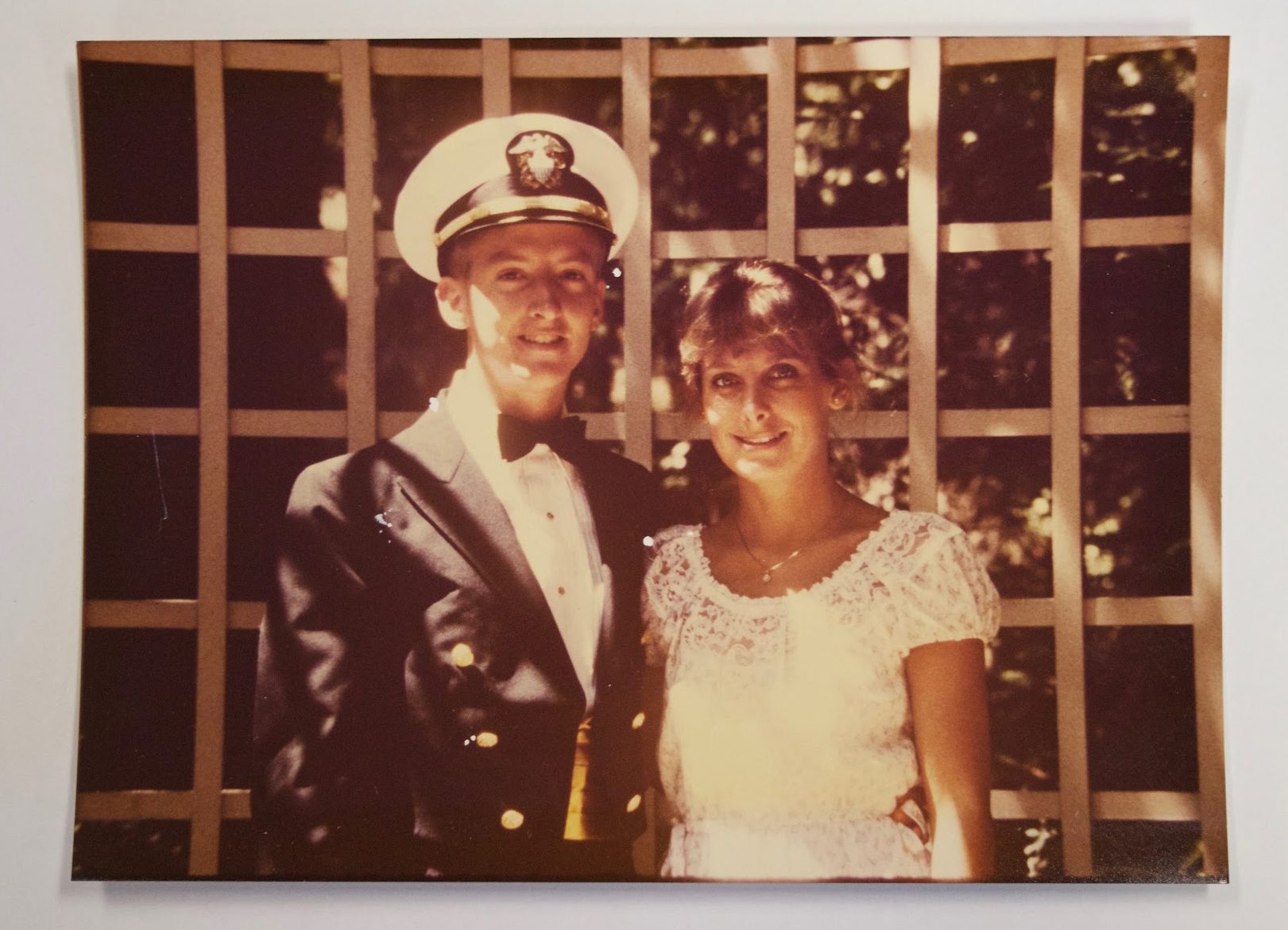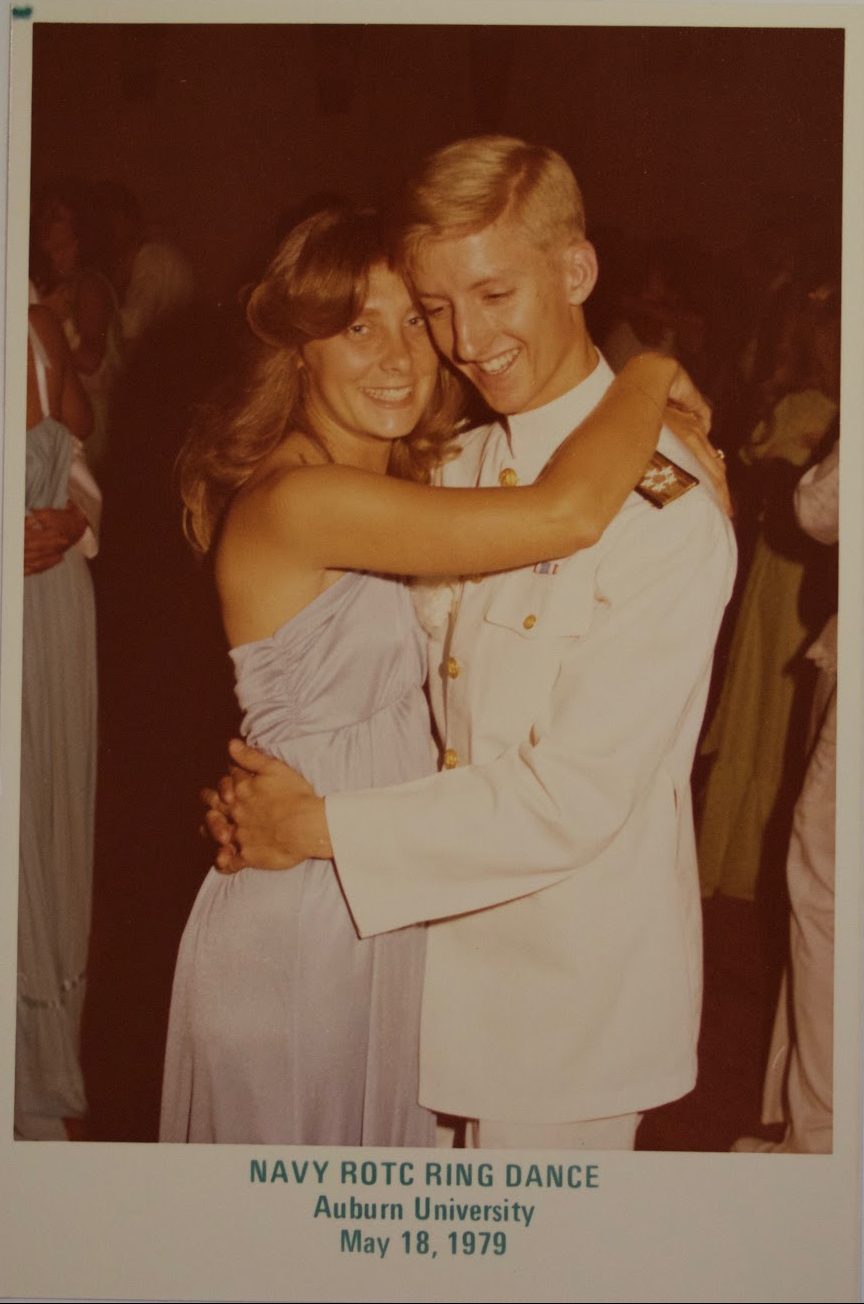A love begun on the Plains outlasts the Cold War, and then some.

The only thing that’s lasted longer than Jim Holt’s career as a Navy submarine hunter is his marriage to his wife, Jan. Both are equally as important and inextricably linked.
Junior year, Holt ‘80 was introduced to Jan “by my dorm neighbor Jim Richardson. He was like Clint Eastwood — he had girls all over the place,” Jim said. They went to the Capri Dormitory, next to Mama Goldberg’s, which is long since torn down. “I go in the dorm and see her sitting there. There’s eight of them in this small room and I walked over to her and introduced myself.”
“I was knee-deep in engineering, trying to pass my classes and, of course, I had an attraction to her, and she to me,” he said. The two began to spend more time together, even attending the ROTC Midshipman Ball. Holt was nominated as Fleet Admiral, so “the boys” made him shoulder boards with 5 stars on them.
Another night, Jan taught him how to ‘spark’. “She said to me, ‘Take this spearmint Lifesaver and put it in your mouth and I’ll put one in my mouth.’ We got underneath a bush where it was really dark and she told me to crunch down on my Lifesaver. She did hers and I did mine and sparks flew.”
While courting her, Holt said, “I went over one night and she came to the door. I looked at her and asked, ‘Can I kiss you?’ She said yes.”
Senior year, Holt flew out to California to visit Jan, engagement ring in tow. “My mom sewed the ring on the inside of my shirt so I wouldn’t lose it. I went into her room one day and said, ‘Will you marry me?’ We were in the bedroom that she grew up in when I gave her the ring and she cried. Here we are 35 years later.”
The couple was engaged while he went to flight school in Pensacola, Fla., beginning his military career in a T-34 — a single engine trainer. From there he learned how to fly a twin engine airplane at the Naval Air Station in Corpus Christi, Texas. “Once you finish that training, you get your ‘wings of gold’ — your pilot wings,” Holt said. In May 1981, he was winged. Seven days later they were married in Birmingham; Jim Richardson was their best man
Moving to Moffett, Calif., Holt became proficient in the P-3 Orion — a land-based, anti-submarine aircraft. He would serve the U.. Navy in six-month deployments for the next 20 years.
Holt, a crew of 3 or 4 pilots and a Naval Flight Officer (NFO) would hunt submarines with “sonobuoys” dropped in the water with transducers on them to pick up noise.
“If we fly over a submarine, the NFO’s gear will blink, so he’ll say, ‘Madman, madman’ and that means we’re in the fighting stage, we’re getting ready to drop a torpedo on the sub,” Holt said.
“You’re searching at 8,000 ft. and then you get closer to the ocean as you get closer to where you know he is until you hover on top of him — it’s like riding a rodeo horse.
During the Cold War, he would “passively track” – gathering reconnaissance and information – Russian submarines and constantly trained, doing touch-and-go landing and simulated attacks. “We didn’t do active tracking on Russian subs or ay other foreign sub because that shows an aggressiveness that we didn’t want. They don’t know we’re there unless we get real low to the water and they can hear us. If they’re at periscope depth, they can see us,” Holt said.
When he became senior of his crew, he would train the newest P-3 pilot up. “I’m bringing him under my wing because someone brought me under his,” Holt said.

Once retired from the military, he became a commercial pilot where he now flies for Delta Airlines. His wife returned to the place of their love story where she now works as a Supply Tech for Auburn’s Naval ROTC.
“I’m very proud of what our military does and the sacrifices that are made,” Jim said. “I feel like I’ve accomplished something in my life [and] even though I’m doing something different now, it was very satisfying.”
“I’m very proud of what our military does and the sacrifices that are made,” Jim said. “I feel like I’ve accomplished something in my life [and] even though I’m doing something different now, it was very satisfying.”
The Life of George McMillan ’66
From student government president to lieutenant governor and music festival empresario, George McMillan’s life of public service had an outsized impact on the state of Alabama.
An Eye for Action
From the mound to the mountain, Blake Gordon ’03 has captured life on the edge.
Charting Her Course
From Auburn’s campus to the world’s most advanced warships, Emily Curran ’10 has never forgotten where she found her footing.
The Life of George McMillan ’66
From student government president to lieutenant governor and music festival empresario, George McMillan’s life of public service had an outsized impact on the state of Alabama.
An Eye for Action
From the mound to the mountain, Blake Gordon ’03 has captured life on the edge.
Charting Her Course
From Auburn’s campus to the world’s most advanced warships, Emily Curran ’10 has never forgotten where she found her footing.


